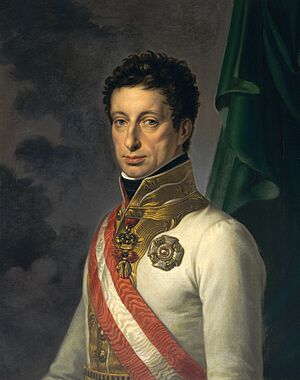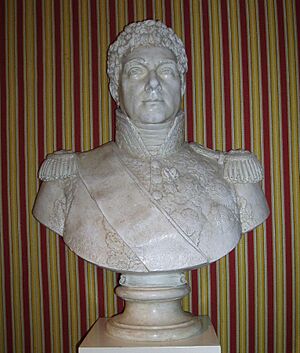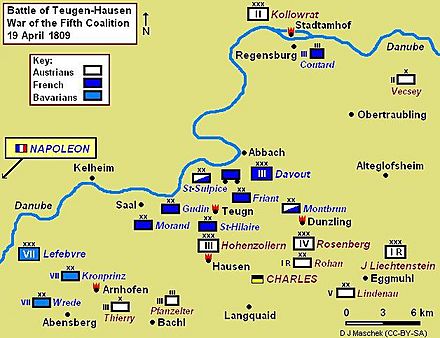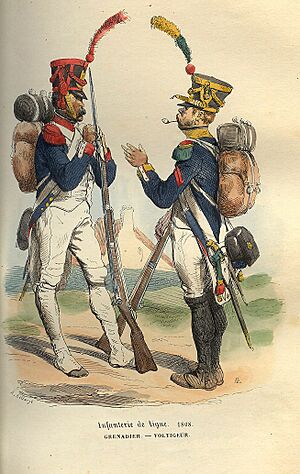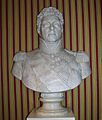Battle of Teugen-Hausen facts for kids
Quick facts for kids Battle of Teugen-Hausen |
|||||||
|---|---|---|---|---|---|---|---|
| Part of the War of the Fifth Coalition | |||||||
 Battle of Teugen-Hausen |
|||||||
|
|||||||
| Belligerents | |||||||
| Commanders and leaders | |||||||
| Units involved | |||||||
| Strength | |||||||
| Teugen-Hausen: 18,000 Dünzling: 12,300 Arnhofen: 5,000 |
Teugen-Hausen: 28,000 Dünzling: 4,000 Arnhofen: 7,600 |
||||||
| Casualties and losses | |||||||
| Teugen-Hausen: 3,862 Dünzling: 1,084 Arnhofen: 400 Total: 4,970 |
Teugen-Hausen: 4,000 Dünzling: 233 Arnhofen: 227 Total: 2,400–4,400 (likely 3,600) |
||||||
The Battle of Teugen-Hausen was an important fight during the War of the Fifth Coalition in 1809. This war was part of the larger Napoleonic Wars. The battle took place on April 19, 1809, near the villages of Teugn and Hausen in modern-day Germany.
In this battle, the French III Corps, led by Marshal Louis-Nicolas Davout, fought against the Austrian III Armeekorps. The Austrian forces were commanded by Prince Friedrich Franz Xaver of Hohenzollern-Hechingen. The French won a tough victory when the Austrians decided to pull back that evening.
This battle was the first day of a four-day campaign. It ended with a major French victory at the Battle of Eckmühl.
Contents
Background to the Battle
Why Austria Went to War
In early 1809, the Austrian Empire decided to go to war against Napoleon. Some leaders in Austria believed it was a good time to fight. They saw that France had faced problems in Spain in 1808.
Archduke Charles was the top commander of the Austrian army. He had spent three years trying to make the army better. He increased the number of soldiers and improved their training. He also organized the army into larger groups called corps, similar to the French system.
However, the Austrian army still had some weaknesses. Their planning was not always the best. Also, some parts of their army, like the local defense forces, were not fully used. Many people in Hungary, part of the Austrian Empire, were not keen on the war.
Archduke Charles sent parts of his army to Italy and Poland. The main Austrian army, with over 200,000 soldiers, was gathered in Bohemia and along the Danube river.
How the Armies Moved
On April 9, 1809, Austria told France that they were at war. The next morning, the Austrian army crossed the Inn River into Bavaria. At first, only a small French and Bavarian force was there to stop them.
Napoleon did not expect the war to start so soon. He thought it would begin after April 15. He had ordered his chief of staff, Louis-Alexandre Berthier, to gather the French army. Berthier was a great helper to Napoleon but not as good at leading an army on his own.
Because of confusing orders, Berthier made a mistake. He told Marshal Davout to gather his troops far to the east, near Regensburg. This left a big gap in the middle of the French army. Napoleon arrived on April 17 and quickly realized the danger. He ordered Davout's troops to move west, away from Regensburg.
By April 18, Napoleon understood that about 80,000 Austrian soldiers were threatening Davout's corps. He planned to send other French forces to help Davout and put pressure on the Austrian army. Archduke Charles also knew he had a chance to defeat Davout's corps.
The Battle of Teugen-Hausen
Troop Movements on April 19
Archduke Charles hoped for a big win on April 19. He ordered his army to attack Davout's French III Corps. His goal was to trap the French against the Danube River. Charles even got a copy of Davout's marching orders for the day.
Charles sent three main groups of soldiers to stop the French. One group went northeast towards Regensburg. Another group, led by Prince Franz Seraph of Orsini-Rosenberg, headed towards Dünzling. The third group, led by Hohenzollern, marched through Hausen and Teugn. This last route was key because it could cut off Davout's escape.
In total, Archduke Charles sent about 65,000 soldiers to try and destroy Davout's French III Corps. Davout, meanwhile, sent his supply wagons along the river road. He had different divisions protecting the wagons and guarding the flanks.
Clashes Around the Area
While the main battle happened at Teugen-Hausen, other smaller fights took place that day.
- Dünzling: Prince Johann Liechtenstein's Austrian troops on the right flank found no French soldiers. Near Dünzling, Austrian forces met French cavalry led by Louis-Pierre Montbrun. Montbrun, with fewer than 4,000 troops, bravely held off a much larger Austrian force all day. He used the wooded areas to his advantage. Montbrun's cavalry caused more damage to the Austrians than they took.
- Arnhofen: An Austrian brigade under Ludwig Thierry clashed with Bavarian troops near Arnhofen. The Bavarian cavalry fought well against the Austrian dragoons. The Bavarians reported fewer casualties and captured some Austrian prisoners.
- Regensburg: A small French force defended Regensburg. Austrian troops attacked the town but were pushed back by the French. The French held the town but were running out of ammunition.
The Main Fight at Teugen and Hausen
The main battle began when French troops from Saint-Hilaire's division ran into the Austrian III Armeekorps near Hausen. The Austrians quickly pushed the French out of the village. They then set up their defenses on a wooded ridge between Hausen and Teugn.
To give his division time to get ready, Marshal Davout sent about 2,000 French soldiers to attack the 6,000 Austrians and their cannons. This attack didn't push the Austrians back, but it bought time. Another French regiment, the 57th Line Infantry, then charged and took the first ridge, but they couldn't get past a second ridge. The fighting was very intense, with lots of gunfire.
Both sides received more soldiers. The French 72nd and 105th Line Infantry Regiments arrived. For the Austrians, Alois Liechtenstein brought up more troops. The Austrians tried to attack the French left side through the woods. But the French 72nd Line quickly moved to stop them. They caught the Austrians as they were trying to get into position and pushed them back.
The Austrians kept trying to attack. One of their cavalry regiments tried to attack the French 57th Line from the side. But the French soldiers quickly formed a square (a defensive formation) and drove the cavalry away. The Austrians attacked again, but the French held their ground.
After a tough fight, the Austrians managed to push the French off the first ridge. Alois Liechtenstein was badly wounded during this attack. There was a short break in the fighting, and Davout personally encouraged his tired soldiers.
Around 3:00 PM, French cannons finally arrived. With this support, the French infantry managed to retake the first ridge. A French officer found a good spot for cannons on the Austrian right side. Saint-Hilaire and the officer quickly planned a new attack. The French attacked from the front, while hidden cannons fired on the Austrians from the side.
Just then, more French troops arrived, aiming for the Austrian right. The hidden cannons opened fire, causing a lot of damage to the Austrians. The Austrians quickly lost ground. Around 5:00 PM, a big thunderstorm started, which finally ended the battle.
What Happened Next
The Austrians reported about 3,862 soldiers killed, wounded, or captured. The French had about 4,000 casualties. Several Austrian generals were wounded, showing how bravely they fought at the front lines.
After the battle, Archduke Charles ordered his troops to retreat. This meant Davout had won, and his army could now connect with the main French forces. That night, Napoleon learned that Davout's corps had escaped the trap. The next day, April 20, the Battle of Abensberg took place.
Historical Note
Napoleon called this battle "Thann." However, historians often call it "Teugen-Hausen" because the main fighting happened between these two villages.
Images for kids


